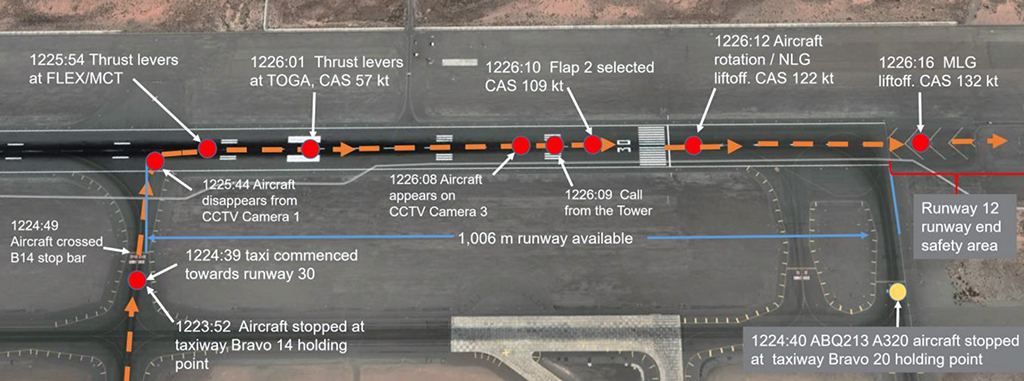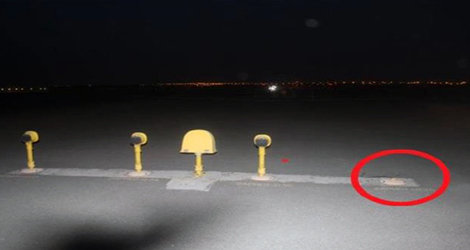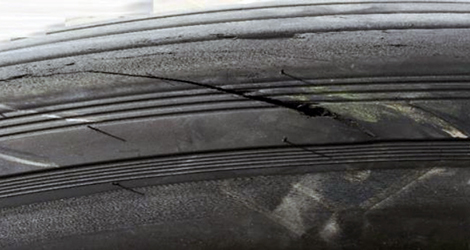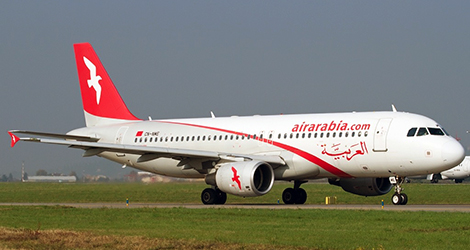On 18 September 2018, Air Arabia Airbus A320 Aircraft, registration A6-ANV, was scheduled to operate commercial flight Air Arabia flight ABY111 from Sharjah International Airport (OMSJ), the United Arab Emirates, to Salalah International Airport (OOSA), Sultanate of Oman.
The flight occupants were the Commander, who was a training captain, the Copilot, whose designation was a second officer under training, 4 cabin crewmembers, and 42 passengers.
The flight crew were off duty for 33 hours before the flight. They arrived at the Operator’s dispatch at approximately 1120 UTC. The flight preparation went normally, and there was no evidence of rushing the before start checklist.
The take-off mass was well below the maximum. The flight documents, including the weather report, operational flight plan (OFP), and departure procedures, were checked and discussed between both flight crewmembers before the flight.
 The Copilot of Air Arabia flight ABY111 was the pilot flying (PF), and it was her first flight to OOSA. The Commander stated that he briefed the Copilot that the taxi would be on a single engine with the second engine start during the taxi.
The Copilot of Air Arabia flight ABY111 was the pilot flying (PF), and it was her first flight to OOSA. The Commander stated that he briefed the Copilot that the taxi would be on a single engine with the second engine start during the taxi.
The Commander briefed the Copilot for intersection and rolling takeoff as part of her training subjects.
The responsibility for engine start and air traffic communications was the Commander’s, whereas the Copilot was responsible for taxiing the Aircraft.
The Aircraft take-off mass was 56.7 tons, center of gravity 27.36%, and the fuel on-board 10,100 kg.
 The Aircraft configuration for takeoff was flap setting of 1+F using engine thrust setting at FLX/MCT (Flex temperature of 67 degrees Celsius).
The Aircraft configuration for takeoff was flap setting of 1+F using engine thrust setting at FLX/MCT (Flex temperature of 67 degrees Celsius).
The OFP ‘take-off data’ speeds were: 122 knots V1; 127 knots VR; and 129 knots V2.
The flight crew entered all relevant flight performance data, including the runway in use ‘runway 30’, in the Aircraft flight management system (FMS) through the multipurpose control and display unit (MCDU). According to the Operator’s procedure, the flight crew were provided with OFP that included the calculated speeds, but it did not include the accelerate-stop distance required to safely stop the Aircraft in case of rejected takeoff.
The OFP stated in the matrix of data that for a takeoff on runway 30 at Bravo 14 intersection, the take-off distance available would be 3,050 meters, which was about 1,000 meters shorter that the runway length. The pushback clearance was given to face east for runway 30.
During the pushback from the parking stand, the left engine (No. 1) was started by the Commander.
At 1220:22, the ground air traffic control (ATC) granted taxi clearance which stated: “taxi runway three-zero, Bravo one-four, taxi Alpha and Alpha 14 at the holding point contact Tower.” At 1220:55, the taxi commenced.
At 1221:43, during the taxi, the right engine (No. 2) start was completed by the Commander and the Aircraft reached Bravo 14 runway 12/30 holding point at 1223.52. The parking brake was set, and the flight crew completed the before takeoff checklist ‘down to the line’.
At 1224:35, the flight data recorder (FDR) confirmed that autobrake MAX deceleration rate was selected, and at 1224:39, the Aircraft parking brake was selected OFF. Shortly after, the Aircraft started moving towards runway 12/30 on idle thrust. At 1225:32, the Copilot increased both engines’ thrust above idle power and started a right turn from heading 30 degrees towards runway 12.
The Commander of Air Arabia flight ABY111 stated that when the Aircraft entered runway 12 his sight was directed inside the cockpit completing the items of the before takeoff checklist.
The Copilot advanced the thrust levers while the Aircraft aligned on runway 12. Tower controller was unaware that the crew had mistakenly turned onto runway 12 instead of runway 30.
At 1225:40, flight ABQ213, A320 aircraft, completed taxiing and stopped at taxiway Bravo 20, holding point for runway 30, waiting for take-off clearance.
At 1225:51, at 20 knots ground speed, the Copilot of Air Arabia flight ABY111 applied a nose down sidestick input of positive 8 degrees and within three seconds had advanced both thrust levers to FLX/MCT position. The Copilot stated that while the ground speed was increasing, she was busy with the monitoring the engine power and line-up.
The copilot then noticed and called out that the flight mode annunciator (FMA) was showing NAV instead of RWY.
At 1225:57, 31 knots ground speed, both engines thrust reached 87% N1, and the Aircraft accelerated from 1 to 4 meters per second. As per the Commander’s statement, he was busy completing the before takeoff checklist and did not realize that the Aircraft had turned right onto runway 12 instead of runway 30. He shortly realized that the Aircraft was on the wrong runway but decided to continue the takeoff believing that the remaining take-off runway available was insufficient to reject the takeoff.
The Commander stated: “I saw the end of runway coming.” He immediately advanced both engine thrust levers to the takeoff/go-around (TOGA) position.
The FDR data indicated that this action occurred at 1226:01, 57 knots calibrated airspeed (CAS), and 63 knots ground speed, and 730 meters remaining runway. The Copilot was still applying a nose down sidestick input of 6 degrees.
At 1226:03, 67 knots CAS (72 knots ground speed), both engines attained TOGA engine thrust, 94.4% N1 speed.
At 1226:09, 106 knots CAS (114 knots ground speed), Tower contacted the flight crew upon noticing the Aircraft rolling at the wrong runway. There was no response from the flight crew.
At 1226:10, 109 knots CAS (120 knots groundspeed), the Commander moved the slat/flap levers to Flap 2 position (CONF2), and accordingly the slats and flaps began to extend. At 1226:12, 122 knots CAS (130 knots ground speed) the Commander initiated a nose-up sidestick input of 8.3 degrees that subsequently increased to 9.2 degrees.
 FDR data recorded the nose landing gear lifted off at this time with a positive increase in Aircraft pitch angle passing 1.9 degrees. Simultaneously, the Copilot was still applying a sidestick nose down of 3 degrees and maintained at this position. At 1226:14, 127 knots CAS (140 knots ground speed), the slats and flaps reached the selected Flap 2 position. The Aircraft pitch-up angle increased up to 9.1 degrees, and at 1226:16, CAS passing 132 knots, the Aircraft lifted off from runway-end safety area at about 30 meters beyond the end of runway 12.
FDR data recorded the nose landing gear lifted off at this time with a positive increase in Aircraft pitch angle passing 1.9 degrees. Simultaneously, the Copilot was still applying a sidestick nose down of 3 degrees and maintained at this position. At 1226:14, 127 knots CAS (140 knots ground speed), the slats and flaps reached the selected Flap 2 position. The Aircraft pitch-up angle increased up to 9.1 degrees, and at 1226:16, CAS passing 132 knots, the Aircraft lifted off from runway-end safety area at about 30 meters beyond the end of runway 12.
At 1226:17, following liftoff, the Aircraft pitch angle decreased to positive 7.7 degrees. Nose-up input of 8.3 degrees was applied again on the Commander’s sidestick, and the Aircraft pitch angle began to increase thereafter. Unknown to the flight crew, during the liftoff, the No. 3 main gear wheel tire struck and damaged a runway approach light.
At 1226:23, the Aircraft radio altitude passing 140 ft and 12.3 degrees pitch-up angle, Tower radioed the flight crew for the second time. At 1226:26, while the Aircraft was at 260 ft above ground level, the Commander responded to Tower. Thereafter, the flight continued uneventfully with the Copilot as the pilot flying. In his interview, the Commander stated that after landing at OOSA, the Operator control center informed the crew about the incident and discussed returning to OMSJ in a scheduled flight.
 He also added that he did not observe Aircraft structural damage or marks on the wheels during the walk-around in OOSA. Accordingly, he decided to return to OMSJ.
He also added that he did not observe Aircraft structural damage or marks on the wheels during the walk-around in OOSA. Accordingly, he decided to return to OMSJ.
The return flight was uneventful, with the Commander as the pilot flying.
3.3 Causes
The Air Accident Investigation Sector of United Arab Emirates (AAIS) determines that the cause of the runway confusion was the Copilot steering the Aircraft right onto the wrong runway during a rolling takeoff. Entry to the wrong runway was due to degraded situation awareness of the Aircraft direction by both flight crewmembers due to lack of external peripheral visual watch and runway confirmation.
3.4 Contributing Factors to the Serious Incident
A contributing factor to the Incident was that the air traffic controller did not monitor the Aircraft movement after take-off clearance was given.
Download Report


0 Comments